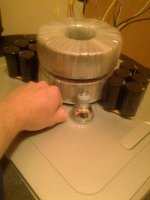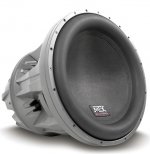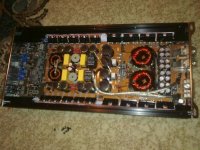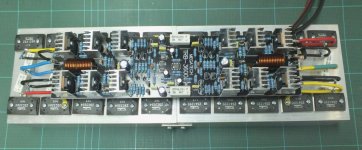What other transistor pairs I can Use instead mg6331/9411? or more powerful
Regards
Regards
Last edited:
🙂
I was searching a litle bit and I found this
The test amplifier:
Non feedbacked triple emitter follower, driven by single stage tube VAS.
The predriver was 2SC3423/2SA1360 pair the driver pair 2SC5171/2SA1930.
Power supply: 200VA EI transfomer 230V/2x28V, 4xSF3004 rectifier, and 2x33000uF BC Components 101 series capacitors.
Source: Marantz SA11S1 SACD player, and HRT Music streamer HD DAC for the PC stored music.
The results:
2SC3519/2SA1386: Little bit thin, with weak bass. The highs and mids are clear, well detailed, and transparent. It has a bit too much highs. The stereo space is well detailed, big, but not so deep.
MG6331/9411: Not enough highs. (Maybe right after the Sankens. Few mninutes after I felt, that is has better balance). Better in bass, but the highs felt a little confused. Maybe some distortion??? The stereo space is good, even not as big as with the Sankens, but little deeper.
NJW0281/0302: The best balance today. Maybe little less highs, than I want, but it's clear, and transparent. The mids are the best today. Seems like a fully tube amplifier. The space wide is average, but it's deeper than any other.
NJW21193/94: Absolutely the worst today The highs and mids are colored, and distorted. The balance is opposite than the Sankens. It has much more bass, and weak highs. (Maybe somebody can fell, that it has lot of highs, but it's only a distortion). The best to drive subwoofers. The space is wide, but we lost the depht. The whole orchestra was pushed in single line, at the front of the stage.
So the winner is the NJW0281/0302. The 2nd place for the Sankens, followed by the Semelabs (very little difference, anyway!), and last is the 21193/94 pair.
Another interesting issue: I have tried them in feedbacked power amplifier (40dB feedback) and the difference was almost impossible to find. So it looks, that in the commonly used amplifiers are not very sensitive for the type of the output devices.
I was searching a litle bit and I found this
The test amplifier:
Non feedbacked triple emitter follower, driven by single stage tube VAS.
The predriver was 2SC3423/2SA1360 pair the driver pair 2SC5171/2SA1930.
Power supply: 200VA EI transfomer 230V/2x28V, 4xSF3004 rectifier, and 2x33000uF BC Components 101 series capacitors.
Source: Marantz SA11S1 SACD player, and HRT Music streamer HD DAC for the PC stored music.
The results:
2SC3519/2SA1386: Little bit thin, with weak bass. The highs and mids are clear, well detailed, and transparent. It has a bit too much highs. The stereo space is well detailed, big, but not so deep.
MG6331/9411: Not enough highs. (Maybe right after the Sankens. Few mninutes after I felt, that is has better balance). Better in bass, but the highs felt a little confused. Maybe some distortion??? The stereo space is good, even not as big as with the Sankens, but little deeper.
NJW0281/0302: The best balance today. Maybe little less highs, than I want, but it's clear, and transparent. The mids are the best today. Seems like a fully tube amplifier. The space wide is average, but it's deeper than any other.
NJW21193/94: Absolutely the worst today The highs and mids are colored, and distorted. The balance is opposite than the Sankens. It has much more bass, and weak highs. (Maybe somebody can fell, that it has lot of highs, but it's only a distortion). The best to drive subwoofers. The space is wide, but we lost the depht. The whole orchestra was pushed in single line, at the front of the stage.
So the winner is the NJW0281/0302. The 2nd place for the Sankens, followed by the Semelabs (very little difference, anyway!), and last is the 21193/94 pair.
Another interesting issue: I have tried them in feedbacked power amplifier (40dB feedback) and the difference was almost impossible to find. So it looks, that in the commonly used amplifiers are not very sensitive for the type of the output devices.
Last edited:
I found price of toshiba TTC5200 here
TTC5200 - TOSHIBA - TRANSISTOR, AUDIO, NPN, 230V,15A | Farnell UK
maybe at the end toshibas give better sound than all the above transistors?
1,52 pounds in UK
TTC5200 - TOSHIBA - TRANSISTOR, AUDIO, NPN, 230V,15A | Farnell UK
maybe at the end toshibas give better sound than all the above transistors?
1,52 pounds in UK
Examine SOA, input capacitance, Vce and other parameters. NJW/MJE4xxx series will give you more power at higher voltages but MGs are still most powerful of the above.
Anyway why do you need so much power?
If you exceed +/-70 odd V then you need 100V caps and these are very expensive and you will need plenty of these. With many power transistors you increase input capacitance and create many other design problems. It's much better to build active system with 2-3 amps per channel. 3-4 pairs of output transistors will do, 80V caps will do, lower voltage and cheaper transformers will do. Active system may cost a bit more although not necessarily. A lot depends on PS voltages. If these are not too high and 63V caps can be used then you'll be saving money.
Anyway, your home wiring most lilely uses 10A wires with 10A fuses per circuit. With 230V AC it allows for 2.3kVA per circuit. If you want to plug in all the power hungry amps and other equipment better put on alert your local fire brigade before switching on as your wiring will melt if your fuses fail to disconnect. Better find efficient speakers.
cheers,
Anyway why do you need so much power?
If you exceed +/-70 odd V then you need 100V caps and these are very expensive and you will need plenty of these. With many power transistors you increase input capacitance and create many other design problems. It's much better to build active system with 2-3 amps per channel. 3-4 pairs of output transistors will do, 80V caps will do, lower voltage and cheaper transformers will do. Active system may cost a bit more although not necessarily. A lot depends on PS voltages. If these are not too high and 63V caps can be used then you'll be saving money.
Anyway, your home wiring most lilely uses 10A wires with 10A fuses per circuit. With 230V AC it allows for 2.3kVA per circuit. If you want to plug in all the power hungry amps and other equipment better put on alert your local fire brigade before switching on as your wiring will melt if your fuses fail to disconnect. Better find efficient speakers.
cheers,
Last edited:
Examine SOA, input capacitance, Vce and other parameters. NJW/MJE4xxx series will give you more power at higher voltages but MGs are still most powerful of the above.
Anyway why do you need so much power?
If you exceed +/-70 odd V then you need 100V caps and these are very expensive and you will need plenty of these. With many power transistors you increase input capacitance and create many other design problems. It's much better to build active system with 2-3 amps per channel. 3-4 pairs of output transistors will do, 80V caps will do, lower voltage and cheaper transformers will do. Active system may cost a bit more although not necessarily. A lot depends on PS voltages. If these are not too high and 63V caps can be used then you'll be saving money.
Anyway, your home wiring most lilely uses 10A wires with 10A fuses per circuit. With 230V AC it allows for 2.3kVA per circuit. If you want to plug in all the power hungry amps and other equipment better put on alert your local fire brigade before switching on as your wiring will melt if your fuses fail to disconnect. Better find efficient speakers.
cheers,
My house wiring is 16Amps and We have 3 phase sistem in the house. My House is from concreet not flamable.
I like powerful amps thats why I would like to make few kilowatt amp
I will use bridged topology then and bridge 2 amps per chanel that way I dont need to use more than 100v capacitors per rail.
that way I will have 180 volts on the speakers with two bridged amps 90v per rail.
Regards
Last edited:
Examine SOA, input capacitance, Vce and other parameters. NJW/MJE4xxx series will give you more power at higher voltages but MGs are still most powerful of the above.
Anyway why do you need so much power?
If you exceed +/-70 odd V then you need 100V caps and these are very expensive and you will need plenty of these. With many power transistors you increase input capacitance and create many other design problems. It's much better to build active system with 2-3 amps per channel. 3-4 pairs of output transistors will do, 80V caps will do, lower voltage and cheaper transformers will do. Active system may cost a bit more although not necessarily. A lot depends on PS voltages. If these are not too high and 63V caps can be used then you'll be saving money.
Anyway, your home wiring most lilely uses 10A wires with 10A fuses per circuit. With 230V AC it allows for 2.3kVA per circuit. If you want to plug in all the power hungry amps and other equipment better put on alert your local fire brigade before switching on as your wiring will melt if your fuses fail to disconnect. Better find efficient speakers.
cheers,
My house wiring is 16Amps and We have 3 phase sistem in the house. My House is from concreet not flamable.
I like powerful amps thats why I would like to make a few kilowatt amp
I will use bridged topology than and bridge 2 amps per chanel
that way I will have 160 volts on the speakers with bridged amps 80v per rail. or maybe even 70volt per rail will be enough
Regards
Last edited:
My House is from concreet not flamable.
so, you have no insulation in your wall, no wood panel on the inside.
do you also have bare concreet flor and roof? steal furnitures? sofa with rock cushions? and a rock bed? no????
then you are pretty flamable!
so, you have no insulation in your wall, no wood panel on the inside.
do you also have bare concreet flor and roof? steal furnitures? sofa with rock cushions? and a rock bed? no????
then you are pretty flamable!
I paid 10euro per capacitor 10 000mf 100v I bought 12 of these have 2 transformers 1.5kw each +/-67AC 120euro per transformer custom built
Anyways transformers pull a little power when just plugged Im not planning to max the volume on the amp when in the house I have circuit brakers in my house so no way I will burn something
Attachments
Last edited:
I just love this thread. A real treat.
I cant wait to see what gets built!!! The next realisation that will be required is that loudspeaker power ratings are - well - not so straight forward.
Oh, and Netkis - unless you are very confident, be cautious about simply increasing the transformer voltage to get more output power. It works in small doses, but at the power levels you are alluding to is very non trivial. Do yourself a favour and simply bridge the biggest amps you can get.
But... Netkis, have you thought through what you are going to put a 1kW sine wave into? Most people would put 1kW into, say one of the following:
- A kettle to boil water
- A room heater
- An arc welder
- A jackhammer
If you think that amplifier ratings get a little fluffy, do some sums on how hot a few grams of copper in a voice coil is going to get. Or given the preceding discussion, perhaps best that you build a kilowatt beast and drive it to clipping.
Please post some photos, and keep this thread running. 🙂
I cant wait to see what gets built!!! The next realisation that will be required is that loudspeaker power ratings are - well - not so straight forward.
Oh, and Netkis - unless you are very confident, be cautious about simply increasing the transformer voltage to get more output power. It works in small doses, but at the power levels you are alluding to is very non trivial. Do yourself a favour and simply bridge the biggest amps you can get.
But... Netkis, have you thought through what you are going to put a 1kW sine wave into? Most people would put 1kW into, say one of the following:
- A kettle to boil water
- A room heater
- An arc welder
- A jackhammer
If you think that amplifier ratings get a little fluffy, do some sums on how hot a few grams of copper in a voice coil is going to get. Or given the preceding discussion, perhaps best that you build a kilowatt beast and drive it to clipping.
Please post some photos, and keep this thread running. 🙂
I just love this thread. A real treat.
I cant wait to see what gets built!!! The next realisation that will be required is that loudspeaker power ratings are - well - not so straight forward.
Oh, and Netkis - unless you are very confident, be cautious about simply increasing the transformer voltage to get more output power. It works in small doses, but at the power levels you are alluding to is very non trivial. Do yourself a favour and simply bridge the biggest amps you can get.
But... Netkis, have you thought through what you are going to put a 1kW sine wave into? Most people would put 1kW into, say one of the following:
- A kettle to boil water
- A room heater
- An arc welder
- A jackhammer
If you think that amplifier ratings get a little fluffy, do some sums on how hot a few grams of copper in a voice coil is going to get. Or given the preceding discussion, perhaps best that you build a kilowatt beast and drive it to clipping.
Please post some photos, and keep this thread running. 🙂
Yes a Jackhammer 😀
Attachments
I have 2kw D class amp in my car 🙂 it twist the metal the windshield wants to explode but its mono 1ohm stable 😀
Attachments
Last edited:
What gets produced should be interesting. 🙂
Something like this x2 just I will make pcb for transistors and output resistors also 🙂
Attachments
Last edited:
how can i use this module for full range... (mid-low)
it is possible ?
you have something else is cheaper better full range
to amplify something like 150-250w rms
that uses the 2sc5200/2sa1943it is possible to replace the2sc5200/2sa1943 with ttc5200 ?
it is possible ?
you have something else is cheaper better full range
to amplify something like 150-250w rms
that uses the 2sc5200/2sa1943it is possible to replace the2sc5200/2sa1943 with ttc5200 ?
Yes, TTC 5200/TTA1943 = 2SC5200/2SA1943 except die size is said to be smaller.......it is possible to replace the2sc5200/2sa1943 with ttc5200 ?....
Download the datasheets from Toshiba and compare for yourself. There are also existing threads about this here and in the parts forum: http://www.diyaudio.com/forums/parts/233303-2sc5200-ttc5200.html
Yes, TTC 5200/TTA1943 = 2SC5200/2SA1943 except die size is said to be smaller.
Download the datasheets from Toshiba and compare for yourself. There are also existing threads about this here and in the parts forum: http://www.diyaudio.com/forums/parts/233303-2sc5200-ttc5200.html
I can not beleive how much fake transistors are on the market I was thinking to use 2SC5200/2SA1943 from FAIRCHILD because I dont know where to buy original toshibas I have nothing against chinese products but they are making bad quality underwattage fake transistors half the wattage of original.Thats not good.They will get bad reputation.
Is anione tried 2SC5200/2SA1943 from FAIRCHILD?
Better to buy FAIRCHILD than fake chiinese transistors?
Regards
Last edited:
- Status
- Not open for further replies.
- Home
- Amplifiers
- Solid State
- eBay Amp 650W AB Class - Someone Try It ?



